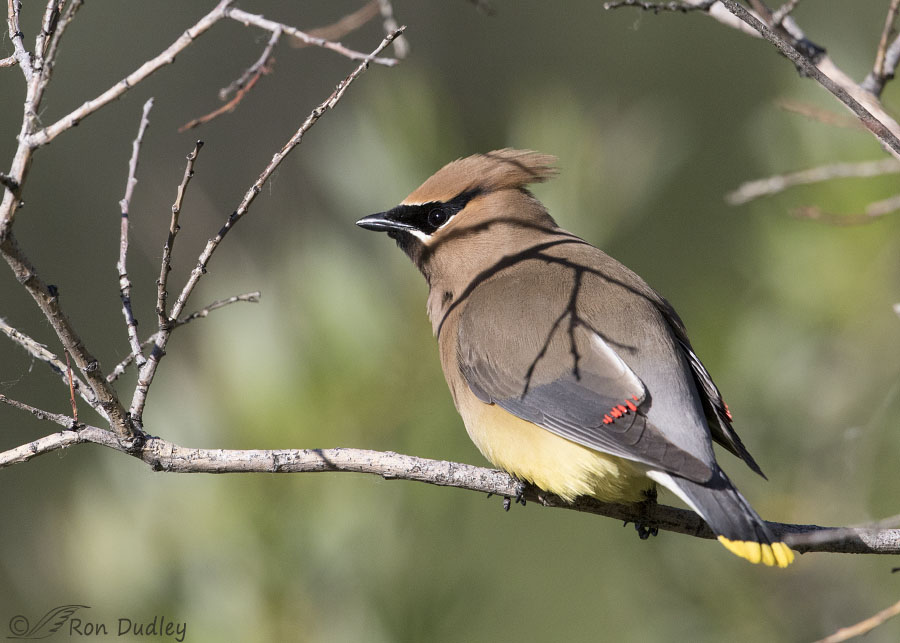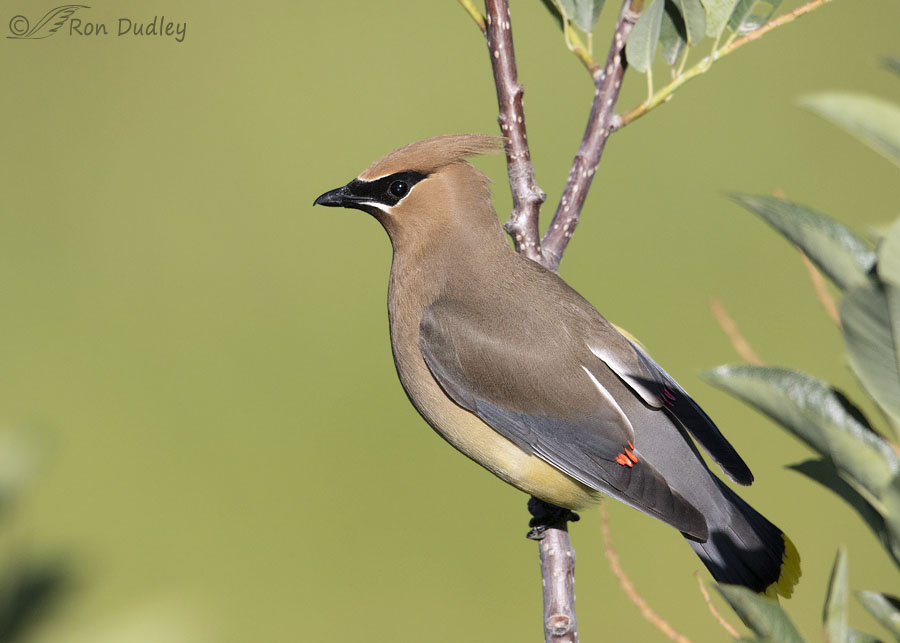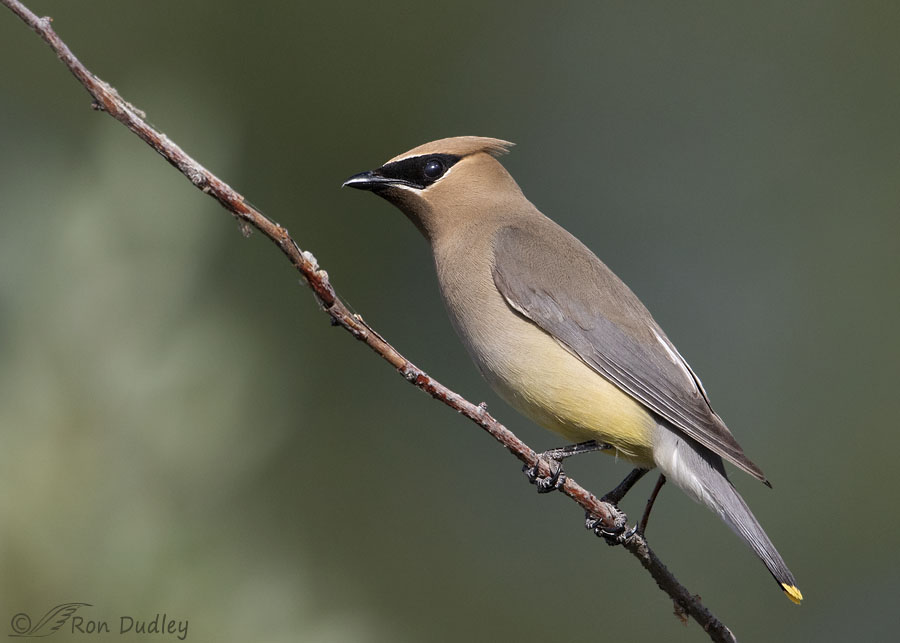This is something I hadn’t even noticed until fairly recently. I need to pay more attention.

As we’ve discussed in the fairly recent past Cedar Waxwings have red waxy tips (appendages) on the ends of some of their wing secondaries. Their waxy appearance is the source of the “waxwing” portion of their common name. The number of waxy tips varies from bird to bird. This one has seven of them on its left wing.

But this waxwing that I posted last month has only four.

I’ve known for some time that the number of red tips varies from bird to bird but until fairly recently I was unaware that some Cedar Waxwings don’t have any waxy tips at all. It was a slow awakening for me. I noticed it in a bird or two but I didn’t think about it much until I photographed this one last month.

Then two days ago I photographed this waxwing without any red tips and I became curious about an explanation – which birds don’t have them and why don’t they have them? Is it a random phenomenon or is it related to sex or age or diet or something else?
Cornell’s Birds of The World makes the following observations on the subject mostly related to age but I found some of it a little difficult to interpret (actually, downright confusing).
- Waxwings in Juvenile Plumage have “wing with fewer waxy appendages”. Fewer than what? I assume fewer than adults.
- Young waxwings in Formative Plumage also have “fewer waxy appendages”. Most have “no waxy tips but 1–3 tips found in about 8% of females and 1–7 tips found in about 8% of males”.
- Adults of both sexes in Definitive Basic Plumage have varying numbers of waxy tips but they average “fewer on Definitive Basic females than on Definitive Basic males.
- Waxy tips can “break off”. I presume this can happen to any waxwing of either sex at any age.
So the answer to my original question isn’t cut and dried, or very clear. Apparently most waxwings I see without waxy tips are younger birds but even young birds can have them. And some adults may be missing some or all of them due to breakage.
To paraphrase my friend Jim DeWitt when he talks about geology on his blog, ornithology is messy. Or at least it can be.
Ron


The blog called them “waxy secretions” at the tip of those feathers. Personally, I’m not buying that explanation at all. Feathers grow out tip first. In other words, the tip is finished first and the blood supply withdraws from the tip as the feather continues to grow out from the body. True, the tip could break off, but there is no mechanism for it to reappear until a new feather starts forming. Um, looking for more research Humph!
I enjoy where your mind wanders. Curiosity is a wonderful thing. I think that the search is more fun than the answers – and we’ve all seen that the answers can sometimes be proven wrong after subsequent study. You may have already seen this, but in case you haven’t, here is a blog with more speculation: https://blog.nature.org/science/2017/02/27/waxwings-really-have-wax-wings/
I think that the search is more fun than the answers.
To a point I agree, Phoebe. The more challenging the search the more rewarding the answer, if you find it. But the flip side is that if you don’t find the answer it’s more frustrating the harder you’ve searched.
That’s why I never give up. Once I found an answer after fourteen years! I don’t dwell on the ones that keep me searching, but I always learn new things on the way,so that keeps me content.
Ron,
Nice shots again, as always. We have an occasional (and I do mean occasional) CWW come to the yard. I have seen them in the mountains (Rockport Reservoir) but have never been close enough to see the appendages of which you speak. I’ll keep looking and shooting.
Stephen
Stephen, I hope you soon get close enough to see them.
So would this be another instance of, “Wax on. Wax off.”? (Sorry, I’ll see myself out now…)
Slam!
Funny, with this discussion and your images of Waxies minus the “wax,” it seems (to me) that — sans red tips — they don’t have quite the same pizazz! However, I shall still gladly watch them herding into my fountain when they decide to return next winter, however they’re dressed.
I think you’re right about the pizazz, Chris. Juvenile birds, most or all who don’t have the waxy tips, are more gray than the adults.
Well THAT clears it right up–NOPE! think David Sparks has the answer that’s closer to right, but he needs an and rather than or. Yes ornithology is messy. And yes, the “human desire for regularity is too demanding” also, simultaneously. And that combined with life is just messy. But darn cedar waxwings are GORGEOUS!
think David Sparks has the answer that’s closer to right, but he needs an and rather than or. Yes ornithology is messy. And yes, the “human desire for regularity is too demanding” also, simultaneously. And that combined with life is just messy. But darn cedar waxwings are GORGEOUS!
Laura, Dave Sparks has a habit of having answers that are “closer to right” than most other folks.
I do find the Birds of the World article a bit confusing as well. I have never seen, or heard of waxy tips on the feathers of any waxwing in juvenile plumage, only adults. I had always understood that most first year birds also did not have the waxy tips and that these were usually only on second year or older birds The number of waxy tips is variable and not a reliable indicator of age or sex, although it has often been assumed that older males have more. However, I’ve never seen direct evidence for this, just someone’s idea. I think it needs further study but that would require the capture and study of many birds over a wide area. A huge task. A part of what makes nature study fun (and sometimes frustrating) is that there are always more questions than answers and the more answers we get, the more questions arise.
Dan, That article needs to be cleaned up! It’s unnecessarily confusing and I suspect it isn’t completely accurate. That account was last edited in 2014 – it badly needs to be done again. Not up to the usual standards of either Cornell or Birds of the World.
Dan’s information agrees with what I read in the ABA periodical on their “Year of the Cedar Waxwing”
Just another variance in plumage.
Never had a juvie in rehab with red tips. I have noticed the number of waxy tips varies from bird to bird and some have none. I’ve assumed on the adults it was more a breeding thing and they broke off. Next time I have a chance to get an adult with tips I will photograph it. They are on the very tip and probably wear off.
April, those tips on the ends of the feathers look both fragile and vulnerable so maybe breakage/wear has more of an effect than one might think.
Ok, it’s time to come clean. I wander the country with a bucket of wax, catching Cedar Waxwings and dipping their feathers in the bucket. Rarely, I will dip the wrong feathers as has been observed (See BotW). They don’t all have this feature; my energy for waxing wanes as the year wears on.
I just hope you’re passing your craft along to the next generation so there will be red-tipped Waxies well into the future!
Lyle, I should have known you were responsible for all the confusion!
Ron, I photographed 5 Cedar Waxwings in mid June and none had the red tips. Since they are late nesters, late July/ early August, that would rule out young birds. Also they had a full pristine plumage, no visible wear. It would be interesting to see if there has been a study of this.
Interesting, Alan.
Every single baby waxwing I’ve raised never had the red tips on their wing, even babies I’ve wintered over didn’t get them.
Probably come in with breeding age plumage molt
Jodi
Cape Ann Wildlife inc
Gloucester MA
I agree, Jodi. None of the orphan babies that I’ve raised had red tips.Yellow tail tips, but no red wax. I had assumed that this was the way it is and common knowledge.
Jodi, I think of “babies” as having natal down.
All I know is that BOTW says waxwings in juvenile plumage (July – Dec.) have “fewer” waxy tips. I suppose fewer could include none at all. As written it’s unnecessarily confusing.
As happens so often, I’ve learned something because of your curiosity. That’s one reason I read your blog daily. The pictures, of course, are the other.
Much appreciated, Nancy.
Beautiful photos and good information…a good start to the day! I always thought it was age…a sign of maturity but now I see that is not the case entirely. The 4th photo bird looks like a juvenile where-as I thought the 3rd was adult…goes to show what I know… !
!
Kathy, the juvies are a little ‘grayer’ than the adults.
Colour me fascinated. I do love learning things. Many thanks.
Mind you life is messy (sometimes very messy) so messy ornithology makes complete sense to me.
You make a good point, EC. I believe you’re right.
I always enjoy the types of posts where I learn something new. The nice photography is a bonus. Thanks for this one!
Thanks, David.
Great information! Interesting the difference between the wax tips of the sexes. Variation is variation every species has its own interesting variations!
Thanks for the post, stay safe!
Thank you, Dick.
Interesting even if it doesn’t definitively answer the question! David has a point on we humans DO like definitive!
Great Blue Heron silhouetted against breaking day a minute or 2 ago – fishing must be getting poor upstream – creek dropping and getting “swampy”.
Bees still trying to deal with Baldfaced Hornets……. Sure would like to know where the nest is…….
Sure would like to know where the nest is…….
“creek dropping and getting “swampy””
It’s that time of year isn’t it, Judy. Same thing’s happening here in many places.
Such beautiful photos and good information. Thank you
Thanks, Elizabeth.
Is it ornithology that is messy, or the human desire for regularity too demanding? Thanks for yet another post about something that I did not know.
I’d say a little of both but they’re interdependent. Thanks, Dave.